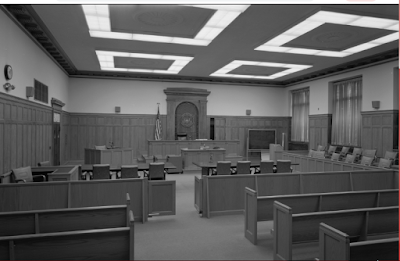 |
| COURT SETTINGS |
Court is a designated place where courts of law are held before a judge or magistrate.
Court settings are the orderly arrangements of the seats in the court. This is otherwise known as court layout. There is the Bench, Registrar's Desk, the Bar, Dock, Witness Box, and Gallery.
COURTROOM SETTINGS
In the settings of a court, the following are found.
1. THE BENCH: This is where the judge, president or magistrate sits. The judge generally sits on a raised desk, known as the bench. Judges usually wear a plain black robe and wig. This depends on the jurisdiction of the court.
2. REGISTRAR'S DESK: This is where registrar and other court clerks sit. It is usually in front of the Judge.
3. THE BAR: It is where the lawyers sit in the court for litigation business of the day. Depending on the jurisdiction; the lawyers must be robed in High courts, Court of Appeal and Supreme Court. Robing is not mandatory in magistrates and customary courts.
The Bar is usually divided to:
a. Inner Bar: This is where Senior Advocates (SAN), Attorney Generals, Life Benchers, and Body Benchers sit in the court.
b. Outer Bar: This is for other lawyers.
In the court, where there is no Inner Bar set out in the court layout. The first roll seat is usually meant for those to sit in the Inner Bar.
4. THE DOCK: This is where the accused person sits/stands. It is to the left-hand side of the bench/judge. An accused cannot enter the Dock with the handcuff, he must be unfettered. An accused person cannot equally give evidence from the dock. He can only make a statement from the dock which he cannot be cross-examined as it is not evidence. when an accused person wants to give evidence he will go the witness box.
5. WITNESS BOX: This is where witnesses stand/sit to give evidence after he has been sworn on oaths or affirmed. Witness box is usually located on the right side of the judge.
6. GALLERY: This is where the general public or spectators sit. lawyers that are not robed, complainants and plaintiffs sit there. Benches and chairs are arranged for the general public who want to observe the proceeding of the court.
SEE ALSO: HOW TO SIGN COURT PROCESSES WHEN MORE THAN ONE LAWYER ARE LISTED
SITTINGS OF THE COURT
The court usually sits on juridical days, this means, days that the courts sit to hear matters. Juridical days include Monday to Friday. Courts do not sit on non-juridical days. Non-juridical days are Sundays and public holidays. A court can, however, sit on Saturday depending on the practice and rules of the court. The court starts sitting from 9 0' clock in the forenoon till 4 0' clock or until the court rises or close for the business of the day.NOTE: The court can sit on Non-juridical days if the parties consented to it.
No comments:
Post a Comment